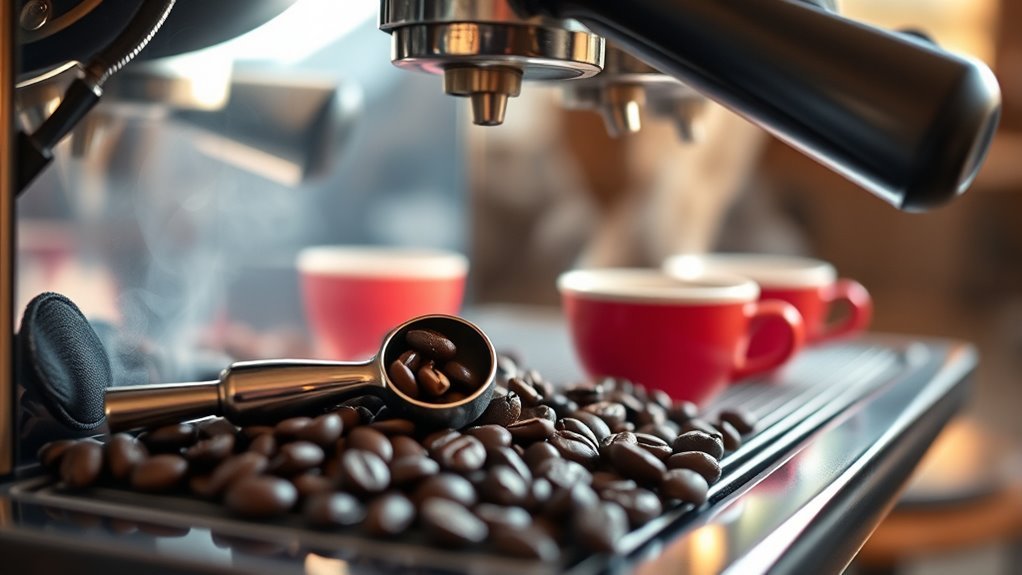Can I Use Coffee Beans in My Espresso Machine
Yes, you can use coffee beans in your espresso machine. However, achieving the best flavor requires attention to grind size, as it affects extraction and taste. Freshly roasted beans, stored properly, enhance aroma and flavor. A fine grind is usually ideal for espresso, but it’s essential to adjust based on your machine’s specifications. Understanding these factors can greatly improve your brewing results. Learn about best practices and tips to elevate your espresso-making skills further.
Understanding Espresso Machines
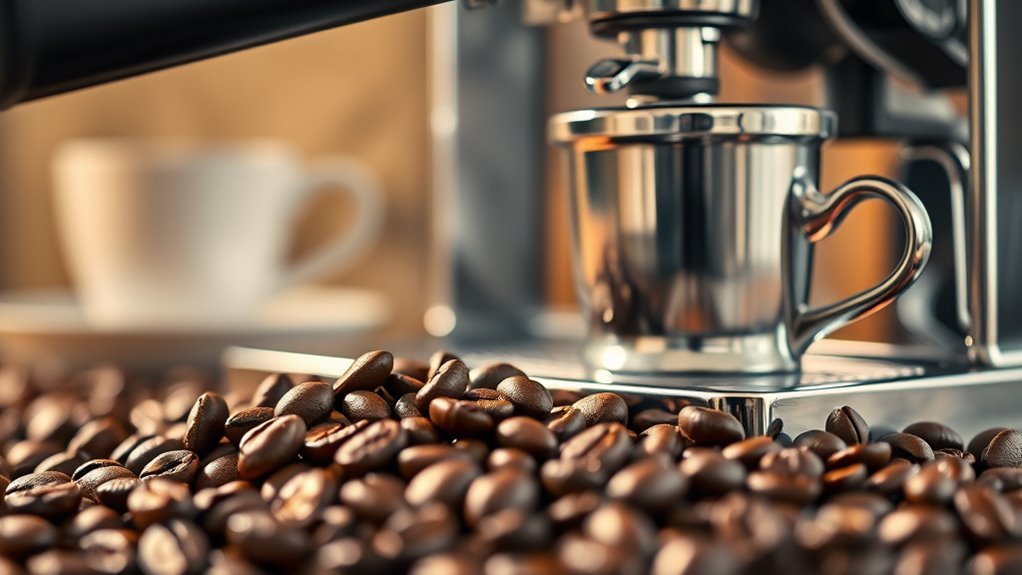
Espresso machines are intricate devices that transform ground coffee into a concentrated beverage through high pressure and heat. You’ll find various espresso machine types, each suited for different brewing preferences and skill levels. Automatic machines offer convenience, while manual models give you control over the espresso brewing methods. Understanding these distinctions helps you choose the right machine for your coffee journey.
When exploring espresso brewing methods, you should consider factors like pressure, temperature, and extraction time. Each method impacts the flavor profile and strength of your espresso. Knowing your options empowers you to craft the perfect shot, allowing you to enjoy the freedom of creating café-quality beverages at home. Embrace the versatility and precision that espresso machines offer, and elevate your coffee experience.
The Importance of Grind Size
When brewing espresso, the grind size of your coffee beans plays an essential role in determining the flavor and extraction quality of the final beverage. An ideal grind consistency guarantees that water flows evenly through the coffee, allowing for peak extraction. If the grind is too coarse, the water will pass through too quickly, leading to under-extraction and a sour taste. Conversely, a grind that’s too fine can create excessive resistance, raising brewing pressure and resulting in over-extraction, which yields bitterness. To achieve the perfect espresso, focus on adjusting your grind size based on your machine’s specifications and your personal taste preferences. This balance will empower you to craft a rich, flavorful espresso that reflects your unique style.
Freshness of Coffee Beans
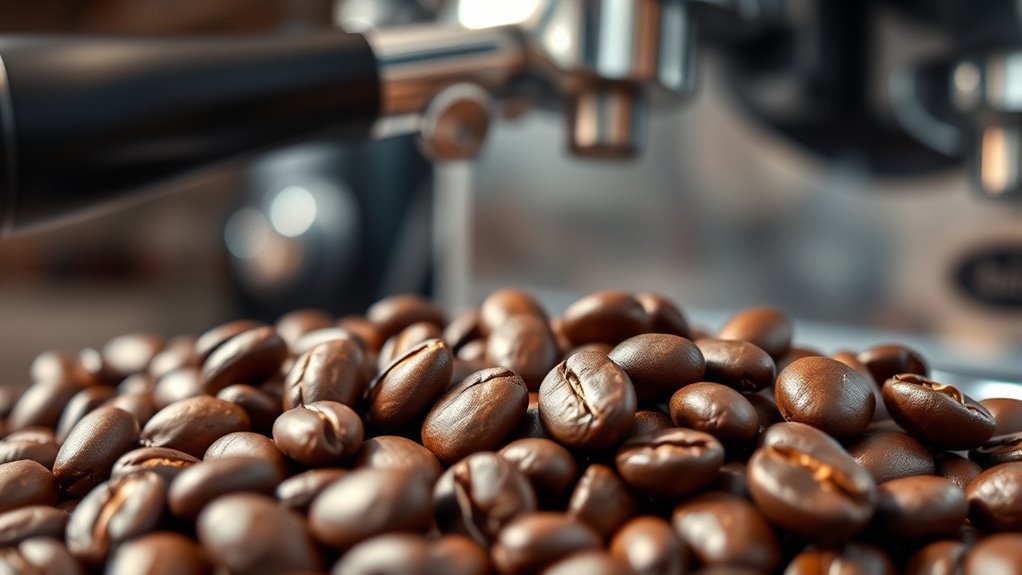
The grind size of your coffee beans may set the stage for extraction, but the freshness of those beans is what truly elevates your espresso experience. Freshly roasted beans, ideally used within a few weeks of their roast date, deliver vibrant flavors and aromas. Proper coffee bean storage is essential; keep them in an airtight container away from light and moisture to maintain their peak freshness.
| Aspect | Impact on Flavor |
|---|---|
| Roast Date | Determines freshness |
| Storage Conditions | Preserves aroma |
| Grind Size | Affects extraction |
| Time Post-Grind | Influences taste |
Types of Coffee Beans for Espresso
Choosing the right type of coffee bean can greatly influence your espresso’s flavor profile and overall quality. In the debate of arabica vs robusta, arabica beans are often favored for their smooth, nuanced flavors, while robusta offers a bolder, earthy taste with higher caffeine content. If you’re aiming for a well-rounded espresso, consider blending these two types to balance flavor and strength. Single origin beans, sourced from a specific region, can also elevate your espresso experience, showcasing unique characteristics tied to their environment. By experimenting with different combinations of arabica and robusta or selecting single origin beans, you can customize your espresso to match your preferences, revealing a world of flavor possibilities in every cup.
How to Grind Coffee Beans for Espresso
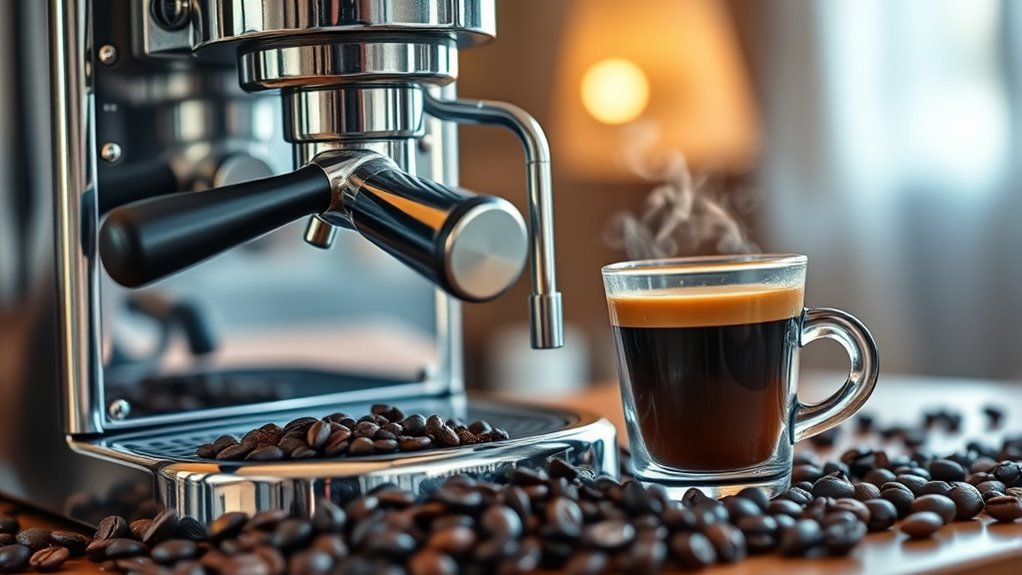
To achieve the perfect espresso, grinding coffee beans correctly is essential, as the grind size greatly impacts extraction and flavor. For espresso, you’ll want a fine grind, resembling table salt. There are several grinding techniques you can use, including blade grinders and burr grinders. Burr grinders offer a more consistent size, which is vital for ideal espresso ratios—typically between 1:1.5 and 1:2, depending on your taste. When using a blade grinder, pulse in short bursts to avoid overheating and uneven grinding. Aim for a uniform texture; clumps can hinder even extraction. Experiment with different grind sizes to find what suits your palate best, as mastering this step reveals the full potential of your espresso experience.
Adjusting Settings on Your Espresso Machine
Adjusting the settings on your espresso machine is essential for achieving the perfect shot. The grind size directly affects extraction, while the brew temperature can enhance or diminish flavor profiles. Understanding these elements allows you to fine-tune your brewing process for ideal results.
Grind Size Importance
While the grind size of your coffee beans may seem like a minor detail, it plays an essential role in the extraction process of your espresso. The right grind consistency can dramatically impact flavor extraction, leading to a truly satisfying cup. Here are key factors to take into account:
- Coarseness: A coarser grind may lead to under-extraction, resulting in a weak flavor.
- Fineness: An overly fine grind can cause over-extraction, yielding bitter notes.
- Uniformity: Consistency in grind size guarantees even extraction, promoting balanced flavors.
- Adjustment: Regularly tweak your settings based on bean type and roast to optimize flavor.
Brew Temperature Settings
The grind size isn’t the only factor that influences the quality of your espresso; brew temperature also plays a significant role in the extraction process. Finding the ideal extraction requires you to fine-tune your machine’s settings. Typically, brew temperature should hover around 190°F to 205°F. Lower temperatures may lead to sour flavors, while higher temperatures can produce bitterness.
| Brew Temperature | Flavor Profile |
|---|---|
| 190°F | Bright, Fruity |
| 195°F | Balanced, Sweet |
| 200°F | Rich, Full-bodied |
| 205°F | Bold, Bitter |
| 210°F | Over-extracted, Harsh |
Experimenting within this range allows you to craft the espresso that suits your palate, granting you the freedom to explore flavors.
Common Mistakes When Using Whole Beans

When using whole coffee beans in your espresso machine, it’s easy to overlook certain details that can greatly impact your brew. Many people fall victim to common misconceptions that can hinder their coffee experience. Here are some common mistakes to avoid:
Using whole coffee beans in your espresso machine requires attention to detail to avoid common mistakes that can ruin your brew.
- Improper Bean Storage: Failing to store beans in an airtight container can lead to stale coffee.
- Using Old Beans: Freshness matters; using beans older than two weeks can diminish flavor.
- Incorrect Grind Size: Not grinding beans finely enough for espresso can result in weak shots.
- Ignoring Brew Time: Over-extraction or under-extraction can occur if you don’t monitor brew time closely.
Benefits of Using Whole Coffee Beans
Using whole coffee beans can greatly enhance your espresso experience. Freshly ground beans offer superior flavor and aroma compared to pre-ground options, ensuring a more vibrant cup. Additionally, grinding your beans allows for custom consistency tailored to your brewing preferences, maximizing the overall quality of your beverage.
Freshness and Flavor Enhancement
While many coffee enthusiasts may overlook the importance of bean freshness, the impact on flavor and aroma is undeniable. Using whole coffee beans can greatly enhance your espresso experience. Here’s how:
- Flavor Profile: Fresh beans provide a richer, more complex flavor profile that elevates your cup.
- Aroma Retention: Whole beans retain their aroma much better than pre-ground options, ensuring that each brew is aromatic and enticing.
- Oxidation Prevention: Keeping beans whole limits their exposure to air, preserving essential oils and flavors.
- Custom Experience: Grinding your beans just before brewing allows for a personalized touch, tailored to your taste preferences.
Custom Grind Consistency
The ability to customize grind consistency is one of the standout advantages of using whole coffee beans. When you control the grind, you enhance grind uniformity and optimize particle distribution, which are essential for achieving the perfect espresso. Different brewing methods require specific grind sizes, and having that flexibility allows you to tailor your coffee experience.
| Grind Size | Particle Distribution | Best For |
|---|---|---|
| Coarse | Larger particles | French press, cold brew |
| Medium | Balanced particles | Drip coffee, pour-over |
| Fine | Smaller particles | Espresso, Aeropress |
| Extra Fine | Very small particles | Turkish coffee |
| Variable | Customized mix | Experimentation |
With whole beans, you’re free to explore and refine your coffee-making skills.
Aromatic Experience Improvement
When you opt for whole coffee beans, you’re not just making a choice for grind consistency; you’re greatly enhancing the aromatic experience of your espresso. The aroma intensity of freshly ground beans transforms your brewing ritual, leading to a richer flavor profile. Here are some key benefits:
- Freshness: Whole beans retain their essential oils longer, preserving their natural fragrances.
- Complexity: Grinding just before brewing reveals intricate flavors that are often lost in pre-ground coffee.
- Customization: You can adjust the grind size to better suit your espresso machine, enhancing overall taste.
- Experience: The ritual of grinding enhances your sensory engagement, making each cup a more profound experience.
Embracing whole beans allows you to enjoy a fuller, more satisfying espresso journey.
Maintenance Tips for Espresso Machines
To guarantee your espresso machine consistently produces high-quality brews, regular maintenance is essential. Start by creating a maintenance checklist that includes cleaning the brew group, descaling the machine every few months, and regularly emptying the drip tray. Pay attention to the water quality; using filtered water can prevent mineral buildup. Additionally, inspect the grinder for clogs and verify it’s calibrated for ideal grind size. Replace the water filter as recommended and routinely check for any leaks or signs of wear. By following these espresso machine upkeep practices, you’ll not only extend the lifespan of your machine but also enhance the quality of your espresso. Regular attention will keep your equipment running smoothly and your coffee experience satisfying.
Brewing the Perfect Espresso Shot
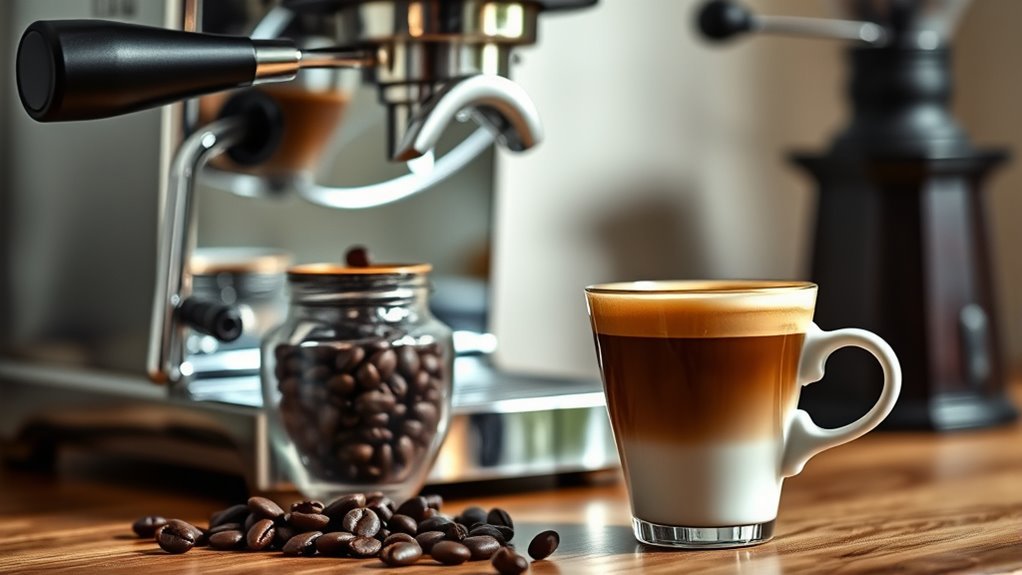
To brew the perfect espresso shot, your choice of coffee beans is essential; their origin and roast profile can greatly impact flavor. You’ll also need to master specific brewing techniques, including grind size and extraction time, to achieve ideal results. Understanding these elements guarantees you create a balanced and rich espresso experience.
Coffee Bean Selection
Selecting the right coffee beans is essential for brewing the perfect espresso shot. Your choice greatly impacts flavor, aroma, and overall experience. Consider these key factors:
- Bean Origin: Different regions produce unique flavor profiles. Explore beans from South America for nuttiness, Africa for fruity notes, or Asia for earthy tones.
- Roast Levels: Light roasts preserve acidity and brightness, while dark roasts offer bold, chocolatey flavors.
- Freshness: Use freshly roasted beans for peak flavor; beans should ideally be used within a month of roasting.
- Grind Size: Confirm your beans are ground to the right consistency for espresso, usually fine, to achieve the best extraction.
Brewing Techniques Explained
While brewing the perfect espresso shot may seem straightforward, mastering the technique requires attention to detail and practice. You’ll want to explore various brewing methods to find what suits your taste. Factors like grind size, water temperature, and extraction time greatly influence the flavor.
Here’s a brief overview of essential elements:
| Element | Importance |
|---|---|
| Grind Size | Affects extraction rate |
| Water Temperature | Influences flavor profiles |
| Brew Ratio | Balances strength and sweetness |
| Extraction Time | Impacts bitterness and smoothness |
Experimenting with espresso variations can also enhance your experience. By adjusting these elements, you can unveil a world of flavors and aromas, allowing you the freedom to create your ideal cup.
Frequently Asked Questions
Can I Use Flavored Coffee Beans for Espresso?
Using flavored coffee beans for espresso can definitely alter the espresso taste. While you can experiment with them, the added flavors might not blend well with the robust characteristics of traditional espresso. It’s important to remember that flavored beans often contain oils, which can clog your machine over time. If you’re looking for a unique twist, consider using them sparingly or in blends to maintain balance while enjoying your freedom to explore different flavors.
How Long Do Coffee Beans Stay Fresh After Opening?
Imagine opening a treasure chest filled with aromatic jewels—coffee beans. Once opened, they’re at their peak for about two weeks, but freshness indicators like aroma and flavor fade quickly. To extend their life, consider storage methods like an airtight container in a cool, dark place. This way, you can savor that delightful essence longer, enjoying each cup as if it were freshly brewed, rather than letting it wither into dullness.
Do Different Espresso Machines Require Specific Coffee Beans?
When considering espresso machine compatibility, it’s vital to know that different machines can indeed require specific coffee bean types. Some machines perform best with finely ground beans, while others may handle coarser grinds. The roast level also plays a role; lighter beans could yield different flavors compared to darker roasts. So, it’s essential to check your machine’s specifications and experiment with various beans to find what works best for your brewing style.
Can I Mix Different Coffee Bean Varieties for Espresso?
Yes, you can mix different coffee bean varieties for espresso. Blending techniques allow you to create unique flavor profiles that enhance your espresso experience. By combining beans with distinct characteristics, you can achieve a balance of acidity, sweetness, and body. Experimenting with different blends gives you the freedom to tailor your espresso to your taste preferences. Just be mindful of the roast levels and flavor nuances to guarantee a harmonious mix.
Is There a Specific Roast Level Best for Espresso?
When it comes to roasting, think of light roast as a sunrise—bright and lively, while dark roast resembles a sunset, rich and deep. For espresso, many prefer a darker roast, as it brings out bold flavors and a creamy body. However, light roasts can offer unique acidity and complexity. Ultimately, it’s about your taste. Experiment with both to find that perfect balance that dances on your palate, embracing your coffee freedom.
